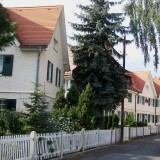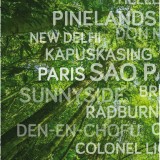Dresden, Germany
First gartenstadt in Germany, located four miles from Dresden and connected to it by tram. Created by Karl Shmidt, owner of furniture company Deutshe Werkstätten für Handwerkskunst (German Workshop for Handcrafted art). The village was arranged around the principle factory, designed by Richard Riemerschmid.
A settlement based on garden city principles offered Schmidt both the space needed to expand his production, as well as providing healthy living conditions for his workforce, close to his factory. Richard Riemerschmid produced a development plan that created distinct areas, as had been used at Letchworth, including an industrial area, workers houses, larger detached houses and public spaces. A commission was established to maintain a harmonious unity between the buildings created by the different architects, which included Hermann Muthesius. Cultural activities were also seen as important part of the community’s development; the Festival Hall was built in 1911 and quickly became renowned for its avant-garde productions, which continues to this day. Now incorporated into the city of Dresden, Hellerau is protected as an historical monument.
Founded: 1906
Original master planner and any other critical master planning, design and architects:
Created by Karl Shmidt, owner of furniture company Deutshe Werkstätten für Handwerkskunst.Planned by (and many houses designed by) Richard Riemerschmid.
Additional architects: Hermann Muthesius, Theodor Fischer, Georg Metzendorf, Henrich Tessenow and Kurt Frick
Architectural Style/qualities:
Commission was established to maintain a unity between buildings created by the different architects.
Settlement Size:
- Originally intended for 8,000 population in 2,000 houses.
- Area 400 acres – 162 hectares (approx. 12 dw/hectare)
Population: 6,275 (2010)
Other notable features that reflect Garden City Principles:
- Separate factory sites, like Letchworth
- Cultural activities important for community development – Festival hall built.
- Mixed-tenure homes and housing types that are affordable for ordinary people;a strong local jobs offer in the Garden City itself, with a variety of employment opportunities within easy commuting distance of homes
- Strong local cultural, recreational and shopping facilities in walkable neighbourhood
- Integrated and accessible transport systems – with a series of settlements linked by rapid transport providing a full range of employment opportunities
Find out more:
http://www.european-garden-city.net/index.php/2012-02-06-15-49-47

